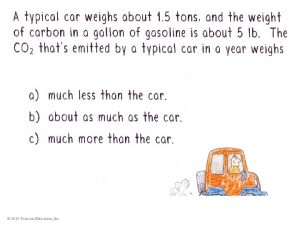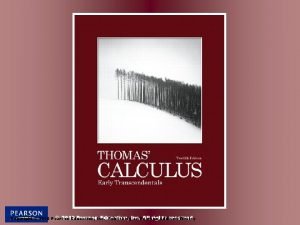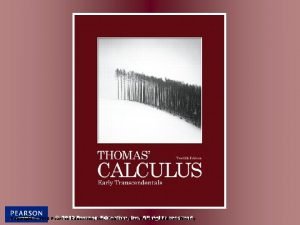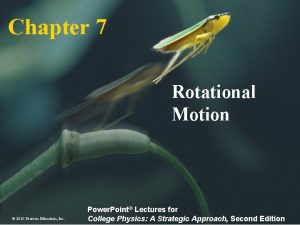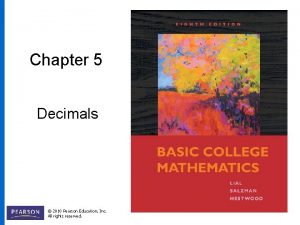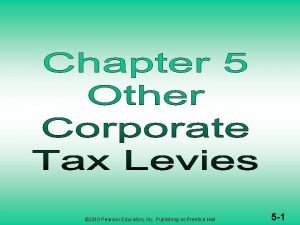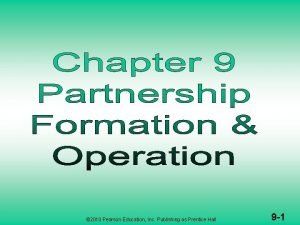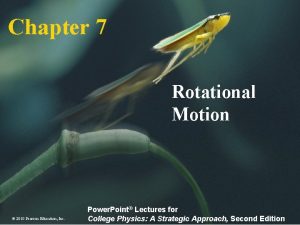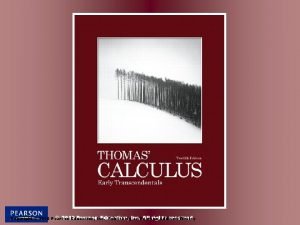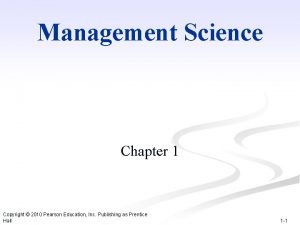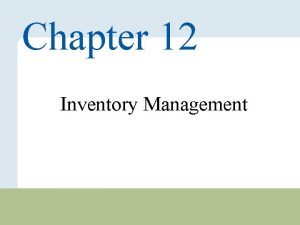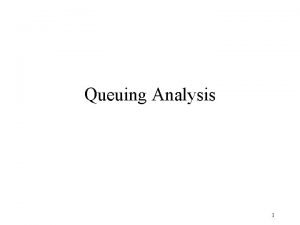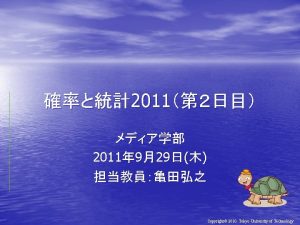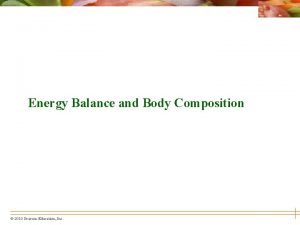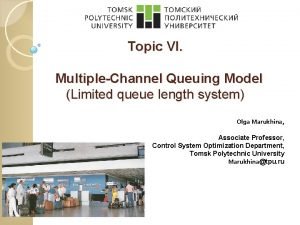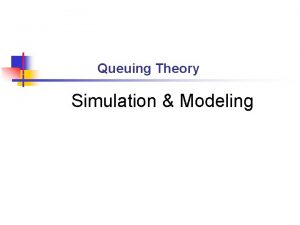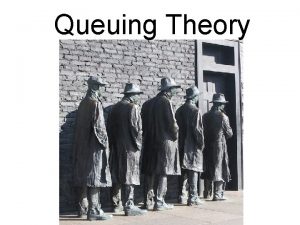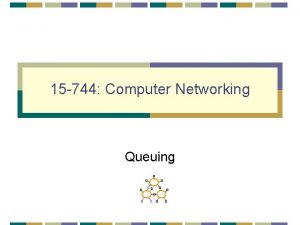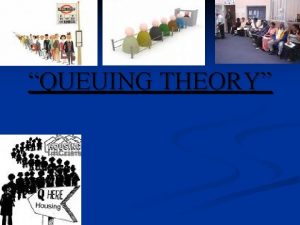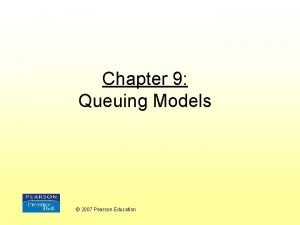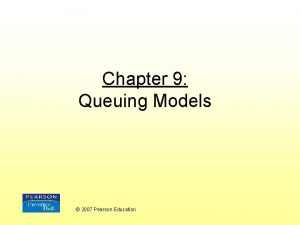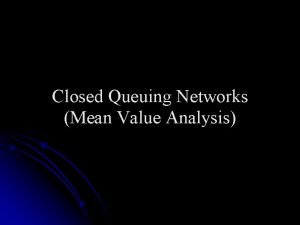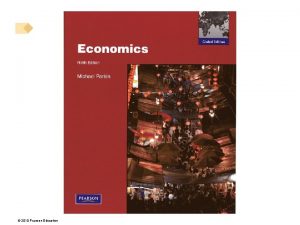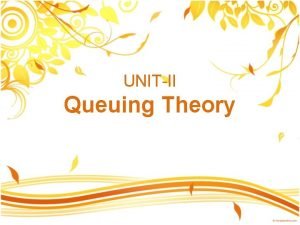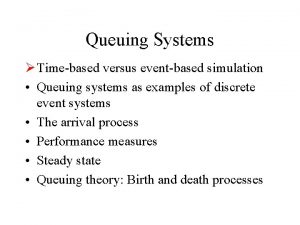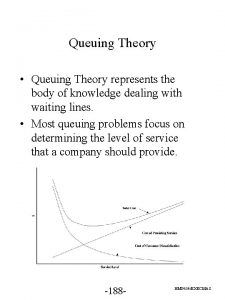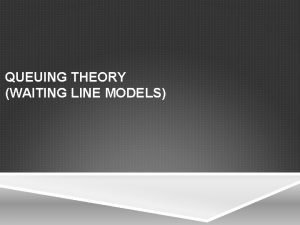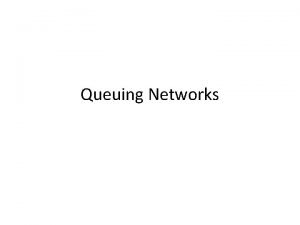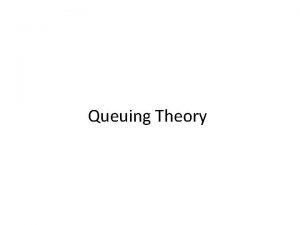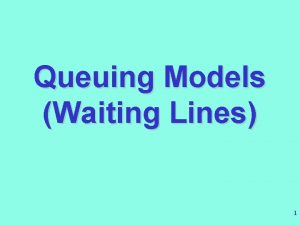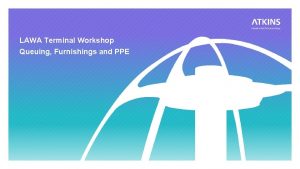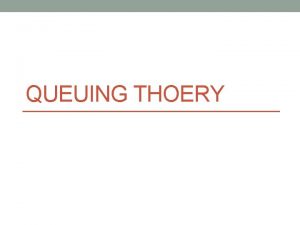Queuing Analysis Chapter 13 Copyright 2010 Pearson Education




























































- Slides: 60

Queuing Analysis Chapter 13 Copyright © 2010 Pearson Education, Inc. Publishing as Prentice Hall 13 -1

Chapter Topics ■ Elements of Waiting Line Analysis ■ The Single-Server Waiting Line System ■ Undefined and Constant Service Times ■ Finite Queue Length ■ Finite Calling Problem ■ The Multiple-Server Waiting Line ■ Additional Types of Queuing Systems Copyright © 2010 Pearson Education, Inc. Publishing as Prentice Hall 13 -2

Overview n Significant amount of time spent in waiting lines by people, products, etc. n Providing quick service is an important aspect of quality customer service. n The basis of waiting line analysis is the trade-off between the cost of improving service and the costs associated with making customers wait. n Queuing analysis is a probabilistic form of analysis. n The results are referred to as operating characteristics. n Results are used by managers of queuing operations to make decisions. Copyright © 2010 Pearson Education, Inc. Publishing as Prentice Hall 13 -3

Elements of Waiting Line Analysis (1 of 2) n Waiting lines form because people or things arrive at a service faster than they can be served. n Most operations have sufficient server capacity to handle customers in the long run. n Customers however, do not arrive at a constant rate nor are they served in an equal amount of time. Copyright © 2010 Pearson Education, Inc. Publishing as Prentice Hall 13 -4

Elements of Waiting Line Analysis (2 of 2) n Waiting lines are continually increasing and decreasing in length and approach an average rate of customer arrivals and an average service time, in the long run. n Decisions concerning the management of waiting lines are based on these averages for customer arrivals and service times. n They are used in formulas to compute operating characteristics of the system which in turn form the basis of decision making. Copyright © 2010 Pearson Education, Inc. Publishing as Prentice Hall 13 -5

The Single-Server Waiting Line System (1 of 2) n Components of a waiting line system include arrivals (customers), servers, (cash register/operator), customers in line form a waiting line. n Factors to consider in analysis: § The queue discipline. § The nature of the calling population § The arrival rate § The service rate. Copyright © 2010 Pearson Education, Inc. Publishing as Prentice Hall 13 -6

The Single-Server Waiting Line System (2 of 2) Figure 13. 1 Copyright © 2010 Pearson Education, Inc. Publishing as Prentice Hall 13 -7

Single-Server Waiting Line System Component Definitions n Queue Discipline: The order in which waiting customers are served. n Calling Population: The source of customers (infinite or finite). n Arrival Rate: The frequency at which customers arrive at a waiting line according to a probability distribution (frequently described by a Poisson distribution). n Service Rate: The average number of customers that can be served during a time period (often described by the negative exponential distribution). Copyright © 2010 Pearson Education, Inc. Publishing as Prentice Hall 13 -8

Single-Server Waiting Line System Single-Server Model n n Assumptions of the basic single-server model: § An infinite calling population § A first-come, first-served queue discipline § Poisson arrival rate § Exponential service times Symbols: = the arrival rate (average number of arrivals/time period) = the service rate (average number served/time period) n Customers must be served faster than they arrive ( < ) or an infinitely large queue will build up. Copyright © 2010 Pearson Education, Inc. Publishing as Prentice Hall 13 -9

Single-Server Waiting Line System Basic Single-Server Queuing Formulas (1 of 2) Probability that no customers are in the queuing system: Probability that n customers are in the system: Average number of customers in system: Average number of customer in the waiting line: Copyright © 2010 Pearson Education, Inc. Publishing as Prentice Hall 13 -10

Single-Server Waiting Line System Basic Single-Server Queuing Formulas (2 of 2) Average time customer spends waiting and being served: Average time customer spends waiting in the queue: Probability that server is busy (utilization factor): Probability that server is idle: Copyright © 2010 Pearson Education, Inc. Publishing as Prentice Hall 13 -11

Single-Server Waiting Line System Operating Characteristics: Fast Shop Market (1 of 2) = 24 customers per hour arrive at checkout counter = 30 customers per hour can be checked out Copyright © 2010 Pearson Education, Inc. Publishing as Prentice Hall 13 -12

Single-Server Waiting Line System Operating Characteristics for Fast Shop Market (2 of 2) Copyright © 2010 Pearson Education, Inc. Publishing as Prentice Hall 13 -13

Single-Server Waiting Line System Steady-State Operating Characteristics Because of steady-state nature of operating characteristics: § Utilization factor, U, must be less than one: U < 1, or / < 1 and < . § The ratio of the arrival rate to the service rate must be less than one or, the service rate must be greater than the arrival rate. § The server must be able to serve customers faster than the arrival rate in the long run, or waiting line will grow to infinite size. Copyright © 2010 Pearson Education, Inc. Publishing as Prentice Hall 13 -14

Single-Server Waiting Line System Effect of Operating Characteristics (1 of 6) Manager wishes to test several alternatives for reducing customer waiting time: 1. Addition of another employee to pack up purchases 2. Addition of another checkout counter. Alternative 1: Addition of an employee (raises service rate from = 30 to = 40 customers per hour). § § Cost $150 per week, avoids loss of $75 per week for each minute of reduced customer waiting time. System operating characteristics with new parameters: Po =. 40 probability of no customers in the system L = 1. 5 customers on the average in the queuing system Copyright © 2010 Pearson Education, Inc. Publishing as Prentice Hall 13 -15

Single-Server Waiting Line System Effect of Operating Characteristics (2 of 6) § System operating characteristics with new parameters (continued): Lq = 0. 90 customer on the average in the waiting line W = 0. 063 hour average time in the system per customer Wq = 0. 038 hour average time in the waiting line per customer U =. 60 probability that server is busy and customer must wait I =. 40 probability that server is available Average customer waiting time reduced from 8 to 2. 25 minutes worth $431. 25 per week. Copyright © 2010 Pearson Education, Inc. Publishing as Prentice Hall 13 -16

Single-Server Waiting Line System Effect of Operating Characteristics (3 of 6) Alternative 2: Addition of a new checkout counter ($6, 000 plus $200 per week for additional cashier). § = 24/2 = 12 customers per hour per checkout counter § = 30 customers per hour at each counter § System operating characteristics with new parameters: Po =. 60 probability of no customers in the system L = 0. 67 customer in the queuing system Lq = 0. 27 customer in the waiting line W = 0. 055 hour per customer in the system Wq = 0. 022 hour per customer in the waiting line U =. 40 probability that a customer must wait I =. 60 probability that server is idle Copyright © 2010 Pearson Education, Inc. Publishing as Prentice Hall 13 -17

Single-Server Waiting Line System Effect of Operating Characteristics (4 of 6) Savings from reduced waiting time worth: $500 per week - $200 = $300 net savings per week. After $6, 000 recovered, alternative 2 would provide: $300 -281. 25 = $18. 75 more savings per week. Copyright © 2010 Pearson Education, Inc. Publishing as Prentice Hall 13 -18

Single-Server Waiting Line System Effect of Operating Characteristics (5 of 6) Table 13. 1 Operating Characteristics for Each Alternative System Copyright © 2010 Pearson Education, Inc. Publishing as Prentice Hall 13 -19

Single-Server Waiting Line System Effect of Operating Characteristics (6 of 6) Figure 13. 2 Cost Trade-Offs for Service Levels Copyright © 2010 Pearson Education, Inc. Publishing as Prentice Hall 13 -20

Single-Server Waiting Line System Solution with Excel and Excel QM (1 of 2) Copyright © 2010 Pearson Education, Inc. Publishing as Prentice Hall Exhibit 13. 1 13 -21

Single-Server Waiting Line System Solution with Excel and Excel QM (2 of 2) Copyright © 2010 Pearson Education, Inc. Publishing as Prentice Hall Exhibit 13. 2 13 -22

Single-Server Waiting Line System Solution with QM for Windows Copyright © 2010 Pearson Education, Inc. Publishing as Prentice Hall Exhibit 13. 3 13 -23

Single-Server Waiting Line System Undefined and Constant Service Times n Constant, rather than exponentially distributed service times, occur with machinery and automated equipment. n Constant service times are a special case of the single-server model with undefined service times. n Queuing formulas: Copyright © 2010 Pearson Education, Inc. Publishing as Prentice Hall 13 -24

Single-Server Waiting Line System Undefined Service Times Example (1 of 2) n Data: Single fax machine; arrival rate of 20 users per hour, Poisson distributed; undefined service time with mean of 2 minutes, standard deviation of 4 minutes. n Operating characteristics: Copyright © 2010 Pearson Education, Inc. Publishing as Prentice Hall 13 -25

Single-Server Waiting Line System Undefined Service Times Example (2 of 2) n Operating characteristics (continued): Copyright © 2010 Pearson Education, Inc. Publishing as Prentice Hall 13 -26

Single-Server Waiting Line System Constant Service Times Formulas n In the constant service time model there is no variability in service times; = 0. n Substituting = 0 into equations: n All remaining formulas are the same as the single-server formulas. Copyright © 2010 Pearson Education, Inc. Publishing as Prentice Hall 13 -27

Single-Server Waiting Line System Constant Service Times Example n Car wash servicing one car at a time; constant service time of 4. 5 minutes; arrival rate of customers of 10 per hour (Poisson distributed). n Determine average length of waiting line and average waiting time. = 10 cars per hour, = 60/4. 5 = 13. 3 cars per hour Copyright © 2010 Pearson Education, Inc. Publishing as Prentice Hall 13 -28

Undefined and Constant Service Times Solution with Excel Copyright © 2010 Pearson Education, Inc. Publishing as Prentice Hall Exhibit 13. 4 13 -29

Undefined and Constant Service Times Solution with QM for Windows Copyright © 2010 Pearson Education, Inc. Publishing as Prentice Hall Exhibit 13. 5 13 -30

Finite Queue Length n In a finite queue, the length of the queue is limited. n Operating characteristics, where M is the maximum number in the system: Copyright © 2010 Pearson Education, Inc. Publishing as Prentice Hall 13 -31

Finite Queue Length Example (1 of 2) Metro Quick Lube single bay service; space for one vehicle in service and three waiting for service; mean time between arrivals of customers is 3 minutes; mean service time is 2 minutes; both inter-arrival times and service times are exponentially distributed; maximum number of vehicles in the system equals 4. Operating characteristics for = 20, = 30, M = 4: Copyright © 2010 Pearson Education, Inc. Publishing as Prentice Hall 13 -32

Finite Queue Length Example (2 of 2) Average queue lengths and waiting times: Copyright © 2010 Pearson Education, Inc. Publishing as Prentice Hall 13 -33

Finite Queue Model Example Solution with Excel Copyright © 2010 Pearson Education, Inc. Publishing as Prentice Hall Exhibit 13. 6 13 -34

Finite Queue Model Example Solution with QM for Windows Copyright © 2010 Pearson Education, Inc. Publishing as Prentice Hall Exhibit 13. 7 13 -35

Finite Calling Population n In a finite calling population there is a limited number of potential customers that can call on the system. n Operating characteristics for system with Poisson arrival and exponential service times: Copyright © 2010 Pearson Education, Inc. Publishing as Prentice Hall 13 -36

Finite Calling Population Example (1 of 2) Wheelco Manufacturing Company; 20 machines; each machine operates an average of 200 hours before breaking down; average time to repair is 3. 6 hours; breakdown rate is Poisson distributed, service time is exponentially distributed. Is repair staff sufficient? = 1/200 hour =. 005 per hour = 1/3. 6 hour =. 2778 per hour N = 20 machines Copyright © 2010 Pearson Education, Inc. Publishing as Prentice Hall 13 -37

Finite Calling Population Example (2 of 2) …System seems woefully inadequate. Copyright © 2010 Pearson Education, Inc. Publishing as Prentice Hall 13 -38

Finite Calling Population Example Solution with Excel and Excel QM (1 of 2) Copyright © 2010 Pearson Education, Inc. Publishing as Prentice Hall Exhibit 13. 8 13 -39

Finite Calling Population Example Solution with Excel and Excel QM (2 of 2) Copyright © 2010 Pearson Education, Inc. Publishing as Prentice Hall Exhibit 13. 9 13 -40

Finite Calling Population Example Solution with QM for Windows Copyright © 2010 Pearson Education, Inc. Publishing as Prentice Hall Exhibit 13. 10 13 -41

Multiple-Server Waiting Line (1 of 3) Copyright © 2010 Pearson Education, Inc. Publishing as Prentice Hall Figure 13. 3 13 -42

Multiple-Server Waiting Line (2 of 3) n In multiple-server models, two or more independent servers in parallel serve a single waiting line. n Biggs Department Store service department; first-come, first-served basis. Copyright © 2010 Pearson Education, Inc. Publishing as Prentice Hall 13 -43

Multiple-Server Waiting Line (3 of 3) Customer Service System at Biggs Department Store Copyright © 2010 Pearson Education, Inc. Publishing as Prentice Hall 13 -44

Multiple-Server Waiting Line Queuing Formulas (1 of 3) n Assumptions: § § § First-come first-served queue discipline Poisson arrivals, exponential service times Infinite calling population. n Parameter definitions: § = arrival rate (average number of arrivals per time period) § = the service rate (average number served per time period) per server (channel) § c = number of servers § c = mean effective service rate for the system (must exceed arrival rate) Copyright © 2010 Pearson Education, Inc. Publishing as Prentice Hall 13 -45

Multiple-Server Waiting Line Queuing Formulas (2 of 3) Copyright © 2010 Pearson Education, Inc. Publishing as Prentice Hall 13 -46

Multiple-Server Waiting Line Queuing Formulas (3 of 3) Copyright © 2010 Pearson Education, Inc. Publishing as Prentice Hall 13 -47

Multiple-Server Waiting Line Biggs Department Store Example (1 of 2) = 10, = 4, c = 3 Copyright © 2010 Pearson Education, Inc. Publishing as Prentice Hall 13 -48

Multiple-Server Waiting Line Biggs Department Store Example (2 of 2) Copyright © 2010 Pearson Education, Inc. Publishing as Prentice Hall 13 -49

Multiple-Server Waiting Line Solution with Excel Copyright © 2010 Pearson Education, Inc. Publishing as Prentice Hall Exhibit 13. 11 13 -50

Multiple-Server Waiting Line Solution with Excel QM Copyright © 2010 Pearson Education, Inc. Publishing as Prentice Hall Exhibit 13. 12 13 -51

Multiple-Server Waiting Line Solution with QM for Windows Copyright © 2010 Pearson Education, Inc. Publishing as Prentice Hall Exhibit 13. 13 13 -52

Additional Types of Queuing Systems (1 of 2) Figure 13. 4 Sequence Single Queues with Single and Multiple Servers in Copyright © 2010 Pearson Education, Inc. Publishing as Prentice Hall 13 -53

Additional Types of Queuing Systems (2 of 2) Other items contributing to queuing systems: § Systems in which customers balk from entering system, or leave the line (renege). § Servers who provide service in other than first-come, first-served manner § Service times that are not exponentially distributed or are undefined or constant § Arrival rates that are not Poisson distributed § Jockeying (i. e. , moving between queues) Copyright © 2010 Pearson Education, Inc. Publishing as Prentice Hall 13 -54

Example Problem Solution (1 of 5) Problem Statement: Citizens Northern Savings Bank loan officer customer interviews. Customer arrival rate of four per hour, Poisson distributed; officer interview service time of 12 minutes per customer. 1. Determine operating characteristics for this system. 2. Additional officer creating a multiple-server queuing system with two channels. Determine operating characteristics for this system. Copyright © 2010 Pearson Education, Inc. Publishing as Prentice Hall 13 -55

Example Problem Solution (2 of 5) Solution: Step 1: Determine Operating Characteristics for the Single. Server System = 4 customers per hour arrive, = 5 customers per hour are served Po = (1 - / ) = ( 1 – 4 / 5) =. 20 probability of no customers in the system L = / ( - ) = 4 / (5 - 4) = 4 customers on average in the queuing system Lq = 2 / ( - ) = 42 / 5(5 - 4) = 3. 2 customers on average in the waiting line Copyright © 2010 Pearson Education, Inc. Publishing as Prentice Hall 13 -56

Example Problem Solution (3 of 5) Step 1 (continued): W = 1 / ( - ) = 1 / (5 - 4) = 1 hour on average in the system Wq = / (u - ) = 4 / 5(5 - 4) = 0. 80 hour (48 minutes) average time in the waiting line Pw = / = 4 / 5 =. 80 probability the new accounts officer is busy and a customer must wait Copyright © 2010 Pearson Education, Inc. Publishing as Prentice Hall 13 -57

Example Problem Solution (4 of 5) Step 2: Determine the Operating Characteristics for the Multiple-Server System. = 4 customers per hour arrive; = 5 customers per hour served; c = 2 servers Copyright © 2010 Pearson Education, Inc. Publishing as Prentice Hall 13 -58

Example Problem Solution (5 of 5) Step 2 (continued): Copyright © 2010 Pearson Education, Inc. Publishing as Prentice Hall 13 -59

Copyright © 2010 Pearson Education, Inc. Publishing as Prentice Hall 13 -60
 Copyright 2010 pearson education inc
Copyright 2010 pearson education inc Copyright 2010 pearson education inc
Copyright 2010 pearson education inc Copyright 2010 pearson education inc
Copyright 2010 pearson education inc Copyright 2010 pearson education inc
Copyright 2010 pearson education inc Copyright 2010 pearson education inc
Copyright 2010 pearson education inc Copyright 2010 pearson education inc
Copyright 2010 pearson education inc 2010 pearson education inc
2010 pearson education inc Copyright 2010 pearson education inc
Copyright 2010 pearson education inc Copyright 2010 pearson education inc
Copyright 2010 pearson education inc Pearson education inc all rights reserved
Pearson education inc all rights reserved Pearson education limited 2017
Pearson education limited 2017 2017 pearson education inc
2017 pearson education inc 2009 pearson education inc
2009 pearson education inc Copyright pearson education inc
Copyright pearson education inc Copyright 2014 pearson education inc
Copyright 2014 pearson education inc Copyright by pearson education inc. answers
Copyright by pearson education inc. answers Copyright 2003 pearson education inc
Copyright 2003 pearson education inc Copyright 2009 pearson education inc
Copyright 2009 pearson education inc 2015 pearson education inc
2015 pearson education inc Copyright 2009 pearson education inc
Copyright 2009 pearson education inc 2009 pearson education inc
2009 pearson education inc Copyright 2009 pearson education inc
Copyright 2009 pearson education inc 2009 pearson education inc
2009 pearson education inc Copyright pearson education inc
Copyright pearson education inc 2010 pearson education inc
2010 pearson education inc 2010 pearson education inc
2010 pearson education inc 2010 pearson education inc answers
2010 pearson education inc answers 2010 pearson education inc answers
2010 pearson education inc answers 2010 pearson education inc answers
2010 pearson education inc answers 2010 pearson education inc
2010 pearson education inc 2010 pearson education inc
2010 pearson education inc 2010 pearson education inc
2010 pearson education inc 2010 pearson education inc answers
2010 pearson education inc answers Pearson education inc 5
Pearson education inc 5 2010 pearson education inc
2010 pearson education inc 2010 pearson education inc
2010 pearson education inc Pearson education inc. all rights reserved
Pearson education inc. all rights reserved Two coins rotate on a turntable
Two coins rotate on a turntable 2010 pearson education inc
2010 pearson education inc 2010 pearson education inc
2010 pearson education inc 2010 pearson education inc answers
2010 pearson education inc answers 2010 pearson education inc
2010 pearson education inc 2010 pearson education inc
2010 pearson education inc Pearson education inc. all rights reserved
Pearson education inc. all rights reserved 2010 pearson education inc answers
2010 pearson education inc answers Income statement pearson example
Income statement pearson example 2010 pearson education inc answers
2010 pearson education inc answers 2010 pearson education inc
2010 pearson education inc Pearson education, inc. publishing as prentice hall
Pearson education, inc. publishing as prentice hall 2011 pearson education inc
2011 pearson education inc Pearson education inc publishing as pearson prentice hall
Pearson education inc publishing as pearson prentice hall Pearson education inc publishing as pearson prentice hall
Pearson education inc publishing as pearson prentice hall 2008 pearson prentice hall inc
2008 pearson prentice hall inc Queuing analysis examples
Queuing analysis examples Copyright 2010
Copyright 2010 Variazioni finanziarie attive
Variazioni finanziarie attive Copyright 2010
Copyright 2010 Nwoz
Nwoz Copyright 2005 pearson prentice hall inc
Copyright 2005 pearson prentice hall inc Pearson 2010
Pearson 2010 Multi channel queuing model
Multi channel queuing model


























